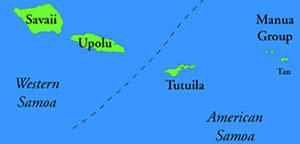
Samoan
Samoan (Gagana Samoa) is a member of the Polynesian group of the Malayo-Polynesian branch of the Austronesian language family. While Samoan is related to other Polynesian languages such as Hawaiian, Fijian, Tahitian and Maori, they are not mutually intelligible having been separated from each other by vast stretches of the Pacific ocean for thousands of years. Ethnologue reports that there are 413,000 speakers of Samoan worldwide, of whom close to 200,000 live in Samoa.

Status
Samoan, along with English, is the official language of both Western Samoa and American Samoa. It is used for everyday communication, in education, and in the media. There are several Samoan/English-language newspapers in Western Samoa, and several institutions of higher learning in both Western and American Samoa.
Dialects
There are no significant dialect differences in Samoan. However, there is a significant difference between the language used to address chiefs and persons of higher status and everyday colloquial language.
Structure
Sound system
Samoan has a small inventory of phonemes, i.e., sounds that make a difference in word meaning. Like all Austronesian languages, it is characterized by a large number of vowels, a small number of consonants, and a simple syllabic structure consisting of either a vowel or consonant + vowel. There are no consonant clusters.
Vowels
Samoan has 5 vowel phonemes, i.e., sounds that can differentiate word meaning. Vowels can be either long or short. Vowel length makes a difference in word meaning. Vowel length is indicated by a macron over the vowel. There are also 7 diphthongs: /au, ao, a,i ae, ei, ou, ue/.
| Close |
i, ī
|
u, ū
|
|
| Mid |
e, ē
|
o, ō
|
|
| Open |
a, ā
|
Consonants
Samoan has 13 consonant phonemes. Consonants in parentheses occur exclusively in loanwords.
| Labiodental | ||||||
|---|---|---|---|---|---|---|
| Stop | voiceless |
p
|
t
|
(k )
|
ʔ
|
|
| voiced |
g
|
|||||
| Fricative | voiceless |
f
|
s
|
(h)
|
||
| voiced |
v
|
|||||
| Nasal |
m
|
n
|
||||
| Lateral |
l
|
|||||
| Rhotic |
(r)
|
- /ʔ/ = sound between vowels in uh-oh; it is represented in writing by ‘.
Grammar
- As is the case in all Austronesian languages, Samoan is an isolating language in which words are not inflected. They consist of roots and particles that are added to roots to indicate grammatical functions.
- Samoan is considered by many linguists to be an ergative-absolutive language, i.e., the subject of intransitive verbs and the direct objects of transitive verbs are in the absolutive (unmarked) case, while the subjects of transitive verbs are in the ergative case. Examples are given below.
|
‘Ua
|
alu
|
le
|
tane
|
‘i
|
Samoa
|
|
|
Perfective
|
go
|
the
|
man
|
to
|
Samoa
|
|
|
‘The man has gone to Samoa.’
|
||||||
|
Na
|
opo
|
e
|
le
|
tane
|
le
|
fafine
|
|
Past
|
hug
|
ergative
|
the
|
man
|
the
|
woman
|
|
‘The man hugged the woman.’
|
||||||
Nouns and pronouns
- Singular number is marked by the article le, e.g., ‘o le ‘ulu ”the breadfruit’. The absence of the article indicates plurality, e.g., ‘o ‘ulu ‘the breadfruits’. Plurality can also be indicated by various count words, e.g., ‘o le motu o tagata ‘a crowd of people’.
- Nouns are not marked for gender or case. Syntactic relationships are marked by prepositions. For instance, possession is marked by the prepositions o and a, e.g., ‘o le faletua o le ali‘i ‘the wife of the chief’.
- Like other Austronesian languages, personal pronouns have a 1st person inclusive form that includes the addressee, and an exclusive form that does not. Personal pronouns distinguish singular, dual, and plural numbers.
- Samoan distinguishes four degrees of proximity/distance to the speaker and listener, e.g., lenei ‘this’ (close to speaker), lena ‘that’ (close to listener), lele ‘that’ (not too far from speaker), lela ‘that’ (far from speaker and listener).
Verbs
- Verbs are not marked for person.
- Samoan marks tense, aspect, mood, causativity, and stativity with separate preverbal particles, e.g., na ‘past’ + opo ‘hug’ = naopo ‘hugged’.
Word order
The normal word order in Samoan sentences is Verb – Subject – Object. A common feature of Samoan is topicalization, i.e., the placement of components that are the topic or focus, at the beginning of sentences.
Vocabulary
Samoan vocabulary is Polynesian in origin. The language relies on reduplication to express plurality, frequency, or augmentation, e.g., pona ‘knot’, ponapona ‘knotty’. The language has also borrowed words from English, e.g., kolisi ‘college’, nusipepa ‘newspaper’.
Registers
Although colloquial language is used in most everyday communication, a special “politeness” register (gagana fa’aaloalo) is used when talking to people of higher status such as tulāfale ‘orator chiefs’ and aliʻi ‘high chiefs’, government officials, teachers, ministers, and elders. This register is characterized by use of honorific terms that signify fa’asamoa ‘respect’, according to traditional Samoan beliefs. An example is the use of the verb tausami ‘to eat’ when speaking to a chief, and taute ‘to eat’ when speaking to the high chief. There is also words expressing self-abasement used when speaking about oneself.
Below are a few common words and phrases in Samoan.
| Hello | Afio Mai! |
| Good bye | Tōfa! |
| Thank you | fa’afetai |
| Please | fa’amolemole |
| Excuse me | tulou lava |
| Yes | ioe |
| No | leai |
| Man | tane |
| Woman | fafine |
Below are Samoan numerals 1-10.
| 1 | 2 | 3 | 4 | 5 | 6 | 7 | 8 | 9 | 10 |
|---|---|---|---|---|---|---|---|---|---|
|
tasi
|
lua
|
tolu
|
fa
|
lima
|
ono
|
fitu
|
valu
|
iva
|
sefulu
|
Writing
Samoan is written with an adapted version of the Latin alphabet. It consists of 15 letters of which H, K, and R are used only for writing loanwords.
|
A a
|
Ā ā
|
E e
|
Ē ē
|
I i
|
Ī ī
|
O o
|
Ō ō
|
U u
|
Ū ū
|
G g
|
L l
|
M m
|
N n
|
P p
|
S s
|
T t
|
V v‘
|
(H h)
|
(K k)
|
(R r)
|
‘
|
- ‘ glottal stop /ʔ/, the sound between vowels in uh-oh.
- macron is used to indicate vowel length, e.g., ā
Take a look at Article 1 of the Universal Declaration of Human Rights in Samoan.
| Mataupu 1 O tagata soifua uma ua saoloto lo latou fananau mai, ma e tutusa o latou tulaga aloaia faapea a latou aia tatau. Ua faaeeina atu i a latou le mafaufau lelei ma le loto fuatiaifo ma e tatau ona faatino le agaga faauso i le va o le tasi i le isi. |
| All human beings are born free and equal in dignity and rights. They are endowed with reason and conscience and should act towards one another in a spirit of brotherhood. |
Difficulty

There is no data on the difficulty level of Samoan for speakers of English.